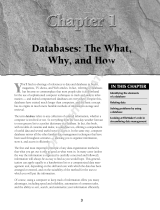
Chapter 2 | Publishing your database on the web 10
4. Choose which users can access the file.
1 The FileMaker Pro Log in using <account name> feature in the File Options dialog box does
not work when accessing files from the web.
1 Web users are not automatically logged in with the Guest account, unless the Guest account is the
only account that has the Instant Web Publishing extended privilege enabled. See
“Logging in to
a file” on page 18 and FileMaker Pro Help for information on enabling the Guest account for
Instant Web Publishing.
1 If you change the Instant Web Publishing access to file setting while users are logged in,
those users do not lose their sessions and can continue using the database until they log out
or their sessions time out. If you make other changes to Instant Web Publishing settings
while guests are logged in to a shared database, guests lose their sessions and are returned
to the Database Homepage. For best results, first close the database, then change settings
when the database is closed, and then restart FileMaker
Pro.
5. Repeat steps 3 and 4 for each database you want to publish.
6. Click OK or choose additional settings.
Tip Select Don’t display in Instant Web Publishing homepage in the Instant Web
Publishing dialog box to suppress a filename from appearing in the built-in Instant Web
Publishing Database Homepage. This is useful if your solution includes multiple files and you
don’t want all the filenames displayed.
Keep these points in mind:
1 The above instructions are for hosting a database with FileMaker Pro. You may want to host
your files with FileMaker
Server Advanced to share your databases with more web users, or to
publish more files. For more information, see
“Hosting databases with FileMaker Server
Advanced: an overview” on page 36.
1 In Mac OS X, you may be asked to provide the operating system password. For more
information, see
“Specifying a port number for web publishing” on page 11.
1 Assigning access to files in the Instant Web Publishing dialog box changes the extended
privilege settings in the associated user’s privilege set. You can review and modify the
Extended Privileges settings directly in the Manage Security dialog box. For more information
on setting or modifying access privileges, see FileMaker
Pro Help.
Choose this To provide access to these users
All users Anyone who has the IP address or domain name of your computer hosting
the database, and an active account and password for the database.
If the Guest account is the only account that has the Instant Web Publishing
extended privilege enabled, web users are automatically logged in.
Specify users by privilege set Allows select users access to the database. Users must enter their account
name and password defined in the Manage Security dialog box.
No users This default setting prevents any user from accessing the database with
Instant Web Publishing.

























